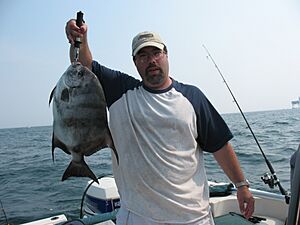Atlantic spadefish facts for kids
Quick facts for kids Atlantic spadefish |
|
|---|---|
 |
|
| Conservation status | |
| Scientific classification | |
| Synonyms | |
The Atlantic spadefish (Chaetodipterus faber) is a cool type of ray-finned fish that lives in the ocean. It belongs to a group of fish called Ephippidae, which are known as spadefishes. This fish is so special that it's even the symbol of the North Carolina Aquariums!
Contents
What's in a Name?
The scientific name for the Atlantic spadefish is Chaetodipterus faber. This name comes from Greek words. "Chaíti" means "mane," and "dipteros" means "with two fins."
The Atlantic spadefish is part of a group called Chaetodipterus. This group also includes two other similar fish:
- The West African spadefish (Chaetodipterus lippei)
- The Pacific spadefish (Chaetodipterus zonatus)
All these spadefish belong to the larger family called Ephippidae. People also call the Atlantic spadefish by other fun names like angelfish, white angelfish, threetailed porgy, ocean cobbler, and moonfish.
What Does It Look Like?
The Atlantic spadefish has a body shaped like a disk, which means it's very tall and flat. Its snout, or nose area, is blunt. It has special fins:
- 9 spines and 21–24 soft rays on its back fin (dorsal fin)
- 3 spines and 17–19 rays on its bottom fin (anal fin)
As they get older, the second dorsal and anal fins grow long, flowing parts. This makes them look a bit like angelfish.
Their bodies are shiny silver. They have 4 to 6 black stripes that go up and down. These stripes fade as the fish gets older. One stripe goes right through its eye, and the last one is near its tail.
The spadefish has a small mouth with tiny, brush-like teeth. It doesn't have teeth on the roof of its mouth. Its head and fins are covered in small, rough scales. These fish usually weigh between 3 and 10 pounds (about 1.4 to 4.5 kg). But some big ones have been found weighing up to 20 pounds (about 9 kg)! They can grow to be about 36 inches (91 cm) long.
What Do They Eat?
Atlantic spadefish are not picky eaters! They mostly eat small creatures that live on the ocean floor. These include:
- Crabs and shrimp (crustaceans)
- Snails and clams (mollusks)
- Worms (annelids)
- Jellyfish and sea anemones (cnidarians)
They also like to eat tiny floating organisms called plankton that drift in the water.
Where Do They Live?
Atlantic spadefish live only in the western part of the Atlantic Ocean. You can find them along the coast of the southeastern United States, as far north as Massachusetts. They also live in the Gulf of Mexico and the Caribbean Sea. You might also spot them near Bermuda and the eastern coast of Brazil.
These fish prefer warm, tropical waters. They are often found in shallow areas near coastlines, usually in water that is 10 to 115 feet (3 to 35 meters) deep. Young spadefish often live in estuaries (where rivers meet the sea) until they grow up. Adult spadefish like to hang out near mangroves, beaches, and harbors.
How Do They Have Babies?
Atlantic spadefish have their babies during the spawning season, which lasts from May to September. A female spadefish can lay a lot of eggs, sometimes up to one million in a single season! The eggs hatch after about 24 hours. The tiny baby fish, called larvae, feed on a yolk sac for two days. After that, they start finding their own food.
Why Are They Important to People?
Atlantic spadefish are not usually caught for big commercial fishing. However, they are very popular with people who enjoy sport fishing. This is because they are known to be strong fighters when caught on a line. They are especially active during the summer months, making them a fun challenge for anglers.
Many people also enjoy eating Atlantic spadefish. They are said to taste very good, especially when smoked or grilled. A common way to catch them is by using small pieces of clam as bait on a small circle hook.
Interesting facts about the Atlantic spadefish
- The name "spadefish" comes from their body shape. From the side, their compressed, deep bodies are vaguely shaped like the spade symbol (♠) found on playing cards.
- While their flat, disc-like bodies might suggest they are slow, they are actually powerful and agile swimmers.
- Spadefish are known for their curiosity. Divers often report that schools will approach and inspect them.
- They are highly social and form large, organized schools, sometimes numbering in the hundreds.
- Despite their uncanny resemblance to freshwater angelfish, they are not closely related at all!
See also
- Ephippidae
- Pacific spadefish
- Chaetodipterus
- Angelfish (disambiguation)
- Recreational fishing




